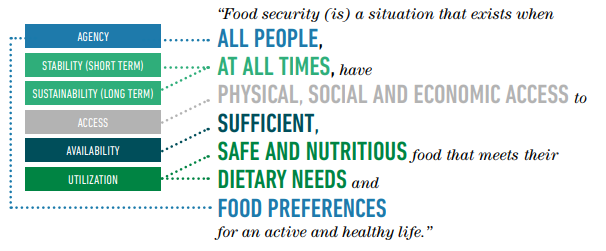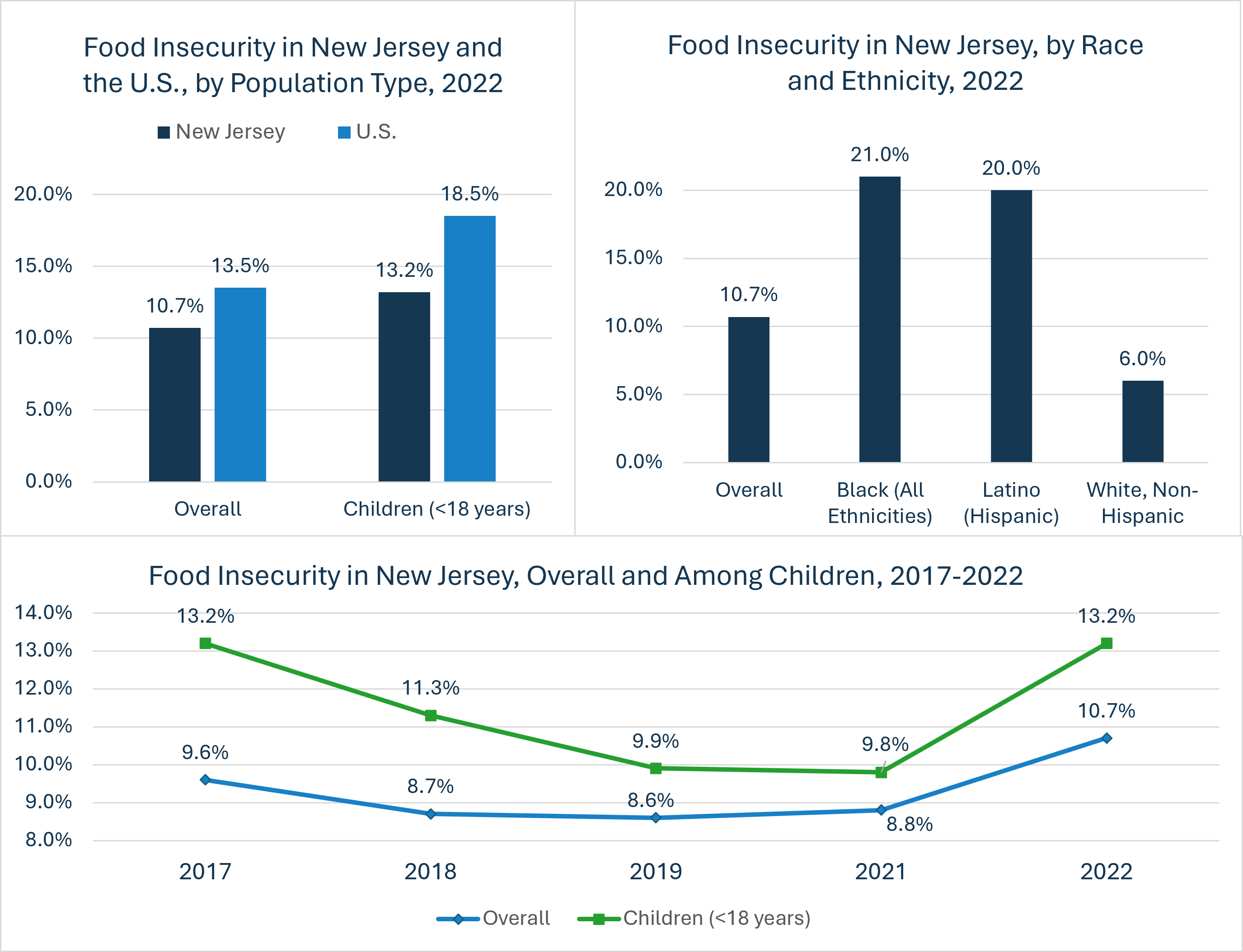Food security is a complex social condition with continually changing and interacting factors and underlying causes. There are multiple ways to define and measure food security. The New Jersey Office of the Food Security Advocate (OFSA) has adopted a definition from the United Nations’ High Level Panel of Experts (HLPE) on Food Security and Nutrition found in the Food Security and Nutrition: Building a Global Narrative Towards 2030 report.
“Food security exists when all people, at all times, have physical, social, and economic access to sufficient, safe, and nutritious food which meets their dietary needs and food preferences for an active and healthy life.”
This definition takes into account six dimensions of food security that ground the work and research of OFSA. The six dimensions are availability, access, utilization, stability, agency, and sustainability. Food insecurity may result from limitations in any of the six dimensions because they all depend on and interact with each other.

Source: HLPE. 2020. Food security and nutrition: building a global narrative towards 2030. A report by the High Level Panel of Experts on Food Security and Nutrition of the Committee on World Food Security, Rome.
The Six Dimensions of Food Security
Focusing on a single indicator or dimension of food security can give an incomplete picture of this complex and dynamic social issue, therefore understanding and measuring the different dimensions of food security is an important step to having a more holistic understanding of the food security status of different populations and therefore can provide better guidance in decision-making.
Availability is the physical presence of foods - Availability refers to individuals having enough quantity, sufficient quality, and nutritional foods physically present in a person’s environment. This includes the supply and distribution of foods at stores, markets, gardens, and other places where individuals obtain food. This dimension takes into account if the available foods can satisfy the dietary needs of individuals, are free from adverse substances, and are acceptable within a given culture.
Access is the resources and means to obtain foods - Access refers to individual or household resources and means needed to obtain appropriate and nutritious foods. This includes both economic and physical resources. This dimension also takes into account the level of resources needed to ensure that access to food does not compromise satisfactory access to other basic needs like housing or health care.
Utilization is the intake of sufficient and safe foods - Utilization refers to the intake of sufficient and safe food and water to meet nutritional needs. This includes individuals' knowledge, skills, and confidence to plan meals and buy, prepare, and cook foods. It also includes their access to food safety knowledge, skills, tools, and resources.
Stability is the reliable supply of foods over time - Stability in food security refers to maintaining adequacy in food availability, access, and utilization over time. Stability includes the ability to ensure the other dimensions of food security are maintained in the event of sudden, short-term shocks, and through cyclical or seasonal changes. For example, the ability to maintain food availability, access, and utilization during a seasonal job layoff, onset of a health condition, periods of inflation, or through a natural disaster. Stability differs from the dimension of sustainability in that stability refers to shorter-term disruptions rather than the long-term sustainability of the food system.
Agency is the power to make decisions about foods eaten and produced - As a dimension of food security, agency refers to individuals’ and communities’ capacity to make decisions and take actions to shape their own relationships with food and food systems. This includes making choices about what they eat, the foods they produce, and how that food is produced, processed, and distributed. Agency also includes the power to engage, in their own terms, in governance structures and policy processes that shape the food system, as well as the ability to address power imbalances within the system.
Sustainability is the food system’s ability to provide long-term food security - Sustainability refers to food system practices that contribute to long-term regeneration of natural, social, and economic systems, ensuring the food needs of the present generations are met without compromising food needs of future generations. Sustainability encompasses the connections between the environment, the economy, society, and the political landscape to maintain food systems and support food security into the distant future.
Explore New Jersey Food Security Information in our Resource Library
Learn more about food security in New Jersey in our resource library.
The State of Food Security in New Jersey
Food insecurity is defined by the U.S. Department of Agriculture (USDA) as a household having a lack of access, at times, to enough food for an active, healthy life for all members of a given household, and limited or uncertain availability of nutritionally adequate foods. USDA measures food insecurity in the U.S. and for each state at the household level. Feeding America’s Map the Meal Gap uses this state-level data to generate county-level estimates based on associations with closely linked indicators, including poverty, unemployment, homeownership, and disability prevalence. Estimates for 2020 are not comparable to other years’ estimates.
Food Insecurity in New Jersey
- In 2022, over 994,000 individuals experienced food insecurity in New Jersey. The food insecurity rate was 10.7% in New Jersey compared to 13.5% in the U.S.
- The rate of food insecurity is higher among children (<18 years) with over 263,000 (13.2%) experiencing food insecurity in New Jersey in 2022.
- Black (all ethnicities) (21.0%) and Latino (Hispanic) (20.0%) individuals experience food insecurity at higher rates than white (6.0%) individuals across New Jersey.
- From 2018 to 2022, food insecurity in New Jersey has gotten worse, changing from 8.7% overall and 11.3% among children to 10.7% overall and 13.2% among children.
Quick Facts
Definition: A lack of access, at times, to enough food for an active, healthy life
Prevalence in New Jersey: 10.7%
Latest Year of Data: 2022
Trends: Getting Worse. Food insecurity has risen from 8.7% overall in 2018 to 10.7% overall in 2022 in New Jersey
Associated Food Security Dimensions: Access, Availability
Methodology
Methodology: Analysis of a household level survey using associations with closely linked social determinants of health
Numerator: Population with a lack of access, at times, to enough food for an active, healthy life or with uncertain availability of nutritionally adequate foods
Denominator: Total population
Data source: Map the Meal Gap
 Official Site of The State of New Jersey
Official Site of The State of New Jersey

